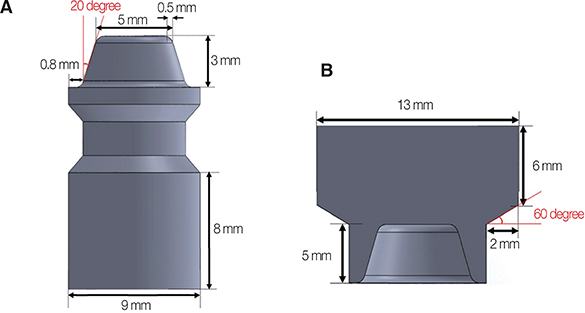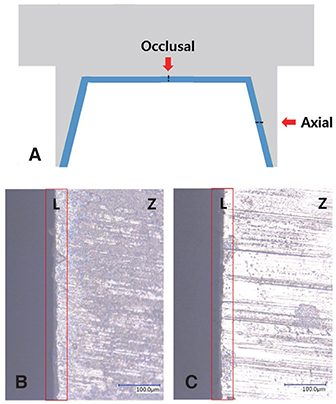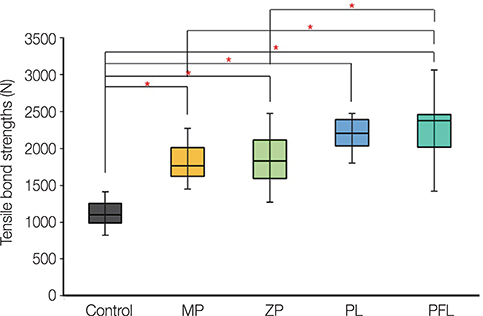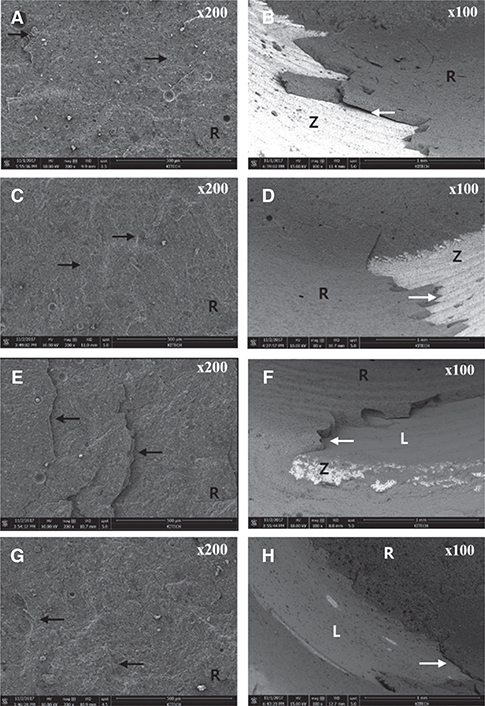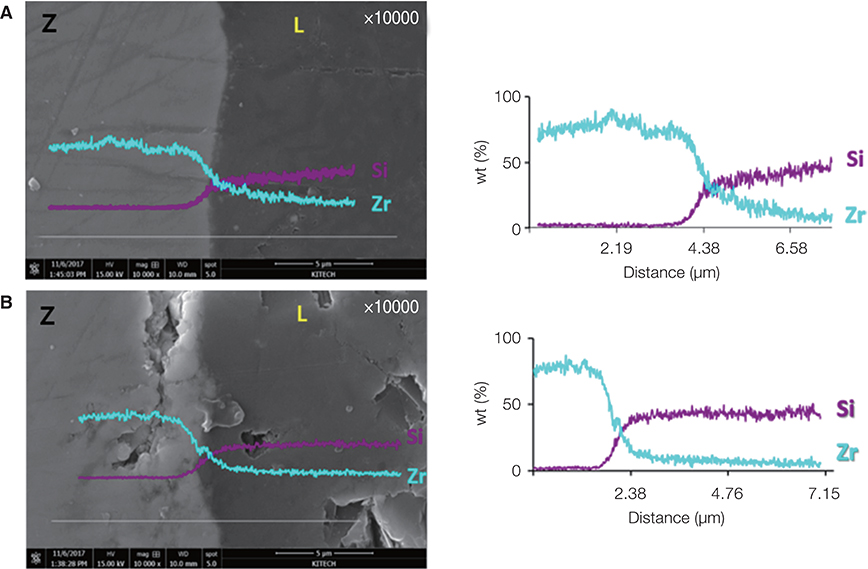J Adv Prosthodont.
2018 Oct;10(5):374-380. 10.4047/jap.2018.10.5.374.
Effect of liners and primers on tensile bond strength between zirconia and resin-based luting agent
- Affiliations
-
- 1Department of Prosthodontics and Research Institute of Oral Science, College of Dentistry, Gangneung-Wonju National University, Gangneung, Republic of Korea. lila@gwnu.ac.kr
- KMID: 2422874
- DOI: http://doi.org/10.4047/jap.2018.10.5.374
Abstract
- PURPOSE
The effect of silica-based glass-ceramic liners on the tensile bond strength between zirconia and resin-based luting agent was evaluated and compared with the effect of 10-methacryloyloxydecyl dihydrogen phosphate (MDP)-containing primers.
MATERIALS AND METHODS
Titanium abutments and zirconia crowns (n = 60) were fabricated, and the adhesive surfaces of the specimens were treated by airborne-particle abrasion. The specimens were divided into 5 groups based on surface treatment: a control group, 2 primer groups (MP: Monobond Plus; ZP: Z Prime Plus), and 2 liner groups (PL: P-containing Liner; PFL: P-free Liner). All specimens were cemented with self-adhesive resin-based luting agent. After 24-hour water storage and thermocycling (5,000 cycles, 5℃/55℃), the tensile bond strength was measured using a universal testing machine. Failure mode analysis and elemental analysis on the bonding interface were performed. The data were analyzed using Kruskal-Wallis test, Dunn's post hoc test, and Fisher's exact test.
RESULTS
The liner groups and primer groups showed significantly higher tensile bond strengths than that of the control group (P < .05). PFL showed a significantly higher tensile bond strength than the primer groups (P < .05). The percentage of mixed failure was higher in the primer groups than in the control group (P < .001), and all the specimens showed mixed failure in the liner groups (P < .001). A chemical reaction area was observed at the bonding interface between zirconia and liner.
CONCLUSION
The application of liner significantly increased the tensile bond strength between zirconia and resin-based luting agent. PFL was more effective than MDP-containing primers in improving the tensile bond strength with the resin-based luting agent.
Keyword
Figure
Reference
-
1. Yi YA, Ahn JS, Park YJ, Jun SH, Lee IB, Cho BH, Son HH, Seo DG. The effect of sandblasting and different primers on shear bond strength between yttria-tetragonal zirconia polycrystal ceramic and a self-adhesive resin cement. Oper Dent. 2015; 40:63–71.
Article2. Schmitter M, Mussotter K, Rammelsberg P, Gabbert O, Ohlmann B. Clinical performance of long-span zirconia frameworks for fixed dental prostheses: 5-year results. J Oral Rehabil. 2012; 39:552–557.
Article3. Ortorp A, Kihl ML, Carlsson GE. A 5-year retrospective study of survival of zirconia single crowns fitted in a private clinical setting. J Dent. 2012; 40:527–530.4. Rinke S, Gersdorff N, Lange K, Roediger M. Prospective evaluation of zirconia posterior fixed partial dentures: 7-year clinical results. Int J Prosthodont. 2013; 26:164–171.
Article5. Heintze SD, Rousson V. Survival of zirconia- and metal-supported fixed dental prostheses: a systematic review. Int J Prosthodont. 2010; 23:493–502.6. Kato H, Matsumura H, Ide T, Atsuta M. Improved bonding of adhesive resin to sintered porcelain with the combination of acid etching and a two-liquid silane conditioner. J Oral Rehabil. 2001; 28:102–108.
Article7. Cavalcanti AN, Foxton RM, Watson TF, Oliveira MT, Giannini M, Marchi GM. Bond strength of resin cements to a zirconia ceramic with different surface treatments. Oper Dent. 2009; 34:280–287.
Article8. Tzanakakis EG, Tzoutzas IG, Koidis PT. Is there a potential for durable adhesion to zirconia restorations? A systematic review. J Prosthet Dent. 2016; 115:9–19.
Article9. Casucci A, Osorio E, Osorio R, Monticelli F, Toledano M, Mazzitelli C, Ferrari M. Influence of different surface treatments on surface zirconia frameworks. J Dent. 2009; 37:891–897.
Article10. Ntala P, Chen X, Niggli J, Cattell M. Development and testing of multi-phase glazes for adhesive bonding to zirconia substrates. J Dent. 2010; 38:773–781.
Article11. Chen C, Chen G, Xie H, Dai W, Zhang F. Nanosilica coating for bonding improvements to zirconia. Int J Nanomedicine. 2013; 8:4053–4062.12. Papia E, Larsson C, du Toit M, Vult von Steyern P. Bonding between oxide ceramics and adhesive cement systems: a systematic review. J Biomed Mater Res B Appl Biomater. 2014; 102:395–413.
Article13. Chen L, Suh BI, Brown D, Chen X. Bonding of primed zirconia ceramics: evidence of chemical bonding and improved bond strengths. Am J Dent. 2012; 25:103–108.14. Kosmac T, Oblak C, Jevnikar P, Funduk N, Marion L. Strength and reliability of surface treated Y-TZP dental ceramics. J Biomed Mater Res. 2000; 53:304–313.15. Blatz MB, Sadan A, Martin J, Lang B. In vitro evaluation of shear bond strengths of resin to densely-sintered high-purity zirconium-oxide ceramic after long-term storage and thermal cycling. J Prosthet Dent. 2004; 91:356–362.
Article16. Kern M, Thompson VP. Bonding to glass infiltrated alumina ceramic: adhesive methods and their durability. J Prosthet Dent. 1995; 73:240–249.
Article17. Awliya W, Odén A, Yaman P, Dennison JB, Razzoog ME. Shear bond strength of a resin cement to densely sintered high-purity alumina with various surface conditions. Acta Odontol Scand. 1998; 56:9–13.
Article18. Blixt M, Adamczak E, Lindén LA, Odén A, Arvidson K. Bonding to densely sintered alumina surfaces: effect of sandblasting and silica coating on shear bond strength of luting cements. Int J Prosthodont. 2000; 13:221–226.19. Khan AA, Al Kheraif AA, Jamaluddin S, Elsharawy M, Divakar DD. Recent trends in surface treatment methods for bonding composite cement to zirconia: A reveiw. J Adhes Dent. 2017; 19:7–19.20. Matinlinna JP, Heikkinen T, Ozcan M, Lassila LV, Vallittu PK. Evaluation of resin adhesion to zirconia ceramic using some organosilanes. Dent Mater. 2006; 22:824–831.
Article21. Chen L, Suh BI, Kim J, Tay FR. Evaluation of silica-coating techniques for zirconia bonding. Am J Dent. 2011; 24:79–84.22. Heikkinen TT, Lassila LV, Matinlinna JP, Vallittu PK. Effect of operating air pressure on tribochemical silica-coating. Acta Odontol Scand. 2007; 65:241–248.
Article23. Yang B, Barloi A, Kern M. Influence of air-abrasion on zirconia ceramic bonding using an adhesive composite resin. Dent Mater. 2010; 26:44–50.
Article24. Kitayama S, Nikaido T, Maruoka R, Zhu L, Ikeda M, Watanabe A, Foxton RM, Miura H, Tagami J. Effect of an internal coating technique on tensile bond strengths of resin cements to zirconia ceramics. Dent Mater J. 2009; 28:446–453.
Article25. Lung CY, Kukk E, Matinlinna JP. The effect of silica-coating by sol-gel process on resin-zirconia bonding. Dent Mater J. 2013; 32:165–172.
Article26. Lee ES, Huh YH, Park CJ, Cho LR. Effect of silica-containing glasseceramic liner treatment on zirconia coping retention. J Prosthet Dent. 2018; 06. 28. pii: S0022-3913(18)30001-5. DOI: 10.1016/j.prosdent.2017.12.005. [Epub ahead of print].27. Aboushelib MN, Kleverlaan CJ, Feilzer AJ. Microtensile bond strength of different components of core veneered all-ceramic restorations. Part II: Zirconia veneering ceramics. Dent Mater. 2006; 22:857–863.28. Kawai Y, Uo M, Watari F. Microstructure evaluation of the interface between dental zirconia ceramics and veneering porcelain. Nano Biomed. 2010; 2:31–36.29. Durand JC, Jacquot B, Salehi H, Fages M, Margerit J, Cuisinier FJ. Confocal Raman microscopic analysis of the zirconia/feldspathic ceramic interface. Dent Mater. 2012; 28:661–671.
Article30. Holand W, Beall GH. Glass ceramic technology. 2nd. Hoboken: John Wiley & Sons;2012. p. 32–45.
- Full Text Links
- Actions
-
Cited
- CITED
-
- Close
- Share
- Similar articles
-
- Effect of denture base surface pretreatments on the tensile bond strength between a resilient liner and a processed denture base resin
- Shear Bonding Strength of Three Cements Luted on Pediatric Zirconia Crowns and Dentin of Primary Teeth
- THE TENSLE BOND STRENGTH AND ELASTIC MODULUS OF THE SOFT DENTURE LINING MATERIALS
- THE STUDY ON THE PHYSICAL PROPERTY OF THE PERMANENT SOFT DENTURE LINERS
- Effect of surface treatment and luting agent type on shear bond strength of titanium to ceramic materials

